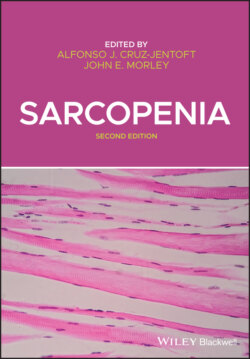Читать книгу Sarcopenia - Группа авторов - Страница 57
How to improve protein retention in older persons: beyond protein quantity? What is the response to increasing protein intakes?
ОглавлениеSurprisingly, only a few experiments were designed to study the effect of increased or decreased protein intake in an older population. When the protein amount in the diet increases from 12 to 21% of total energy, whole body protein turnover was enhanced in older men and women [52]. Following a low protein intake (50% of usual intake), no modification of whole body protein synthesis and breakdown was noticed in a group of aged women [53]. However, whole body protein oxidation, nitrogen balance, muscle mass and function, and immune response were significantly affected in the group fed a low‐protein diet [49]. Collectively, these observations highlight the importance of maintaining adequate protein intakes in older people to counteract the negative effect of aging on protein metabolism. These previous observations were repeated indicating some adaptations using muscle‐specific transcript profiles [54]. Of course, the other important question is about the upper limit of protein intakes in older persons, knowing that a reduced glomerular filtration capacity is occurring. To address this issue, we demonstrated [55] that a high‐protein ingestion, i.e. 3 g/kg fat‐free mass/d for 10 days, was inefficient to enhance protein synthesis at whole body as well as the skeletal muscle levels in healthy older persons in the postabsorptive state. Interestingly, although a high protein diet normally enhanced glomerular filtration rate in young adults, it reduced renal function in the aged group [55]. Other data have shown long ago that the maximal adaptive capacity of ureagenesis in adults (for a mean weight of 70 kg) was about 22 mg of urea nitrogen/kg body weight/h [56]. These data correspond to a maximal protein consumption of ∼3.3 g/kg/d, so that the safe upper limit for protein intake has been fixed to less than 2.2 g/kg/d by the French group on protein recommendation for older persons [57]. In addition, reports have highlighted that the amount of protein consumed per meal is important for muscle mass and function. In fact, consuming frequent meals containing 30–45 g of protein was associated with greater leg lean mass and knee extensor muscle strength [58]. The above mentioned nutritional strategy was also associated with higher appendicular lean body mass (an index of muscle mass) in both older men and women at baseline and after a two‐year follow‐up period [59]. Besides the quantity of protein consumed, the source of protein, the quality of protein, i.e. its digestibility and its composition in EAAs, can modulate protein metabolism and be beneficial for muscle quality.
